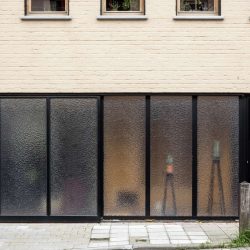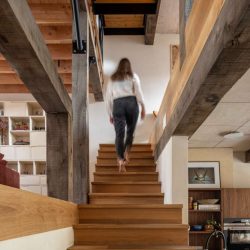
ATELIER VENS VANBELLE . photos: © Tim Van de Velde
Miel and Eline bought Irene’s house with accompanying pub and stable. Not long before, this house was a weekly stop for a handful of farmers from a village outside Ghent. On Thursday mornings at five o’clock there was the weekly cattle market, so every Wednesday evening the cows were unloaded here and escorted to the stable behind the house. Afterward, the former resident Irene served some beers in the café on the street side, just like in about twenty other so-called slaughterhouse cafés in what was considered one of the roughest neighborhoods in Ghent thirty years ago. Today this district is a popular neighborhood with only a few vague memories of the past.
The house itself was in poor condition and the layout was impractical. A renovation would be so drastic that it was decided to rebuild. One of the challenges was to preserve the former atmosphere of the stable and to link it to the house together with the intermediate garden. The beam structure of the roof of the stable is impressive and at the same time feels very familiar, which is why it was decided to extend this feeling to the house.
By copying the old oak beams from the stable to the new house on the street side, few people realize this is a new construction and not a renovation. The front and rear facades were deliberately designed to be neutral or even restrained, and the interior also opted for a modest yet surprising interior. The house feels lived-in, but at the same time translates all the wishes of the residents: from floor heating with a geothermal heat pump to a double shower head, a cat flap, and even a socket for the Christmas lights in the right place.
In order not to have to provide all the living spaces on the ground floor, but also because of orientation and light, the house was constructed with split levels. In this way, the building volume could be kept more compact to maximize the garden, and sunlight can penetrate through the front facade to the very back of the house. There are eight half-stories from the front door to the mezzanine in the children’s rooms.
The staircase in the middle of the house, surrounded by oak beams as a wink to the stable, connects all split levels and provides a beautiful spatial experience and maximum views. Wherever you stand, you always see a window and feel the sunlight. This makes the house feel very light and spacious, and the residents can maintain contact with each other from every floor. Although the stairs and beam structure are very present, the choice of color and materials provides the desired tranquility. On each floor, you get a repetition of the same materials: oak, steel, (poly)concrete, loam, and stainless steel.
The stable was a very dark building, but by removing part of the floors and replacing the old roof covering with transparent corrugated sheets, light now enters generously and the beautiful beam structure creates a fascinating shadowplay. The space feels like a logical extension of the garden and is divided into a seating area and a workspace where Miel maintains his motorcycles. A staircase takes you to a platform where you can sunbathe under a sliding conservatory window.
A brown polished concrete floor was placed in both the house and the stable, and the garden path with the same floor connects both entities. The garden in between is spacious and quiet, which is a rare and special quality at this location in a densely populated neighborhood and so close to the Ghent ring road. A mix of evergreen climbing plants, shrubs and trees grows here with a distinct leaf structure that will make the city walls disappear into the background year after year.
_




























